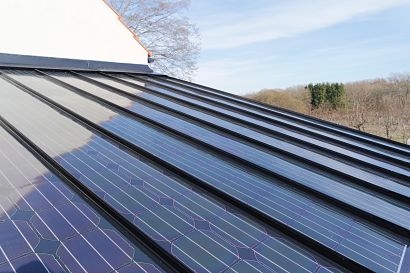
Midsummer produces thin, flexible and cadmium-free solar cells in its research and production facility in Järfälla, Sweden. The company has now increased the power of its solar roofs by increasing the radius of the rounded solar cells from 90mm to 100mm, representing a six percent increase in power and an installed power of 100W per square metre.
”Our customers should not to have to choose between climate-smart energy supply and a beautiful home” said Sven Lindström, CEO, Midsummer. “The combination of minimalist design and high efficiency together with the market's lowest carbon footprint has demand for Midsummer Solar Roofs increase and present production is sold out until March 2020.”
In order to meet the high demand for Midsummer Solar Roofs, additional staff are now being recruited to the production plant in Järfälla, Sweden.
Where traditional solar panels with their fragile and heavy silicon-based solar cells with glass and aluminum frames stand out from the roofs, Midsummer Solar Roofs feature in-house developed CIGS solar cells with light-absorbing layers consisting of copper, indium, gallium and selenium, manufactured in Midsummer's proprietary DUO machines on site at the production facility in Järfälla, Sweden.
The thin film solar panels are only 2 mm thick, very flexible and durable. These are integrated with Midsummer's own folded metal roofs, which are easily connected to chimneys, skylights, covers and valleys, and are also suitable to walk on. The metal roofs are custom-made to optimally match the solar module and maximise the total installed power. This results in a neat, discreet and efficient solar cell roof that is also maintenance-free.
As the production is energy-efficient and the plant only uses Swedish renewable electricity, Midsummer leaves a minimal carbon footprint all the way from production to roof. According to a life-cycle analysis conducted by the leading Swedish industrial research institute Swerea IVF, the production of Midsummer's solar panels results in only one-tenth of the global warming potential (GWP) compared to silicon-based modules.
For additional information:

